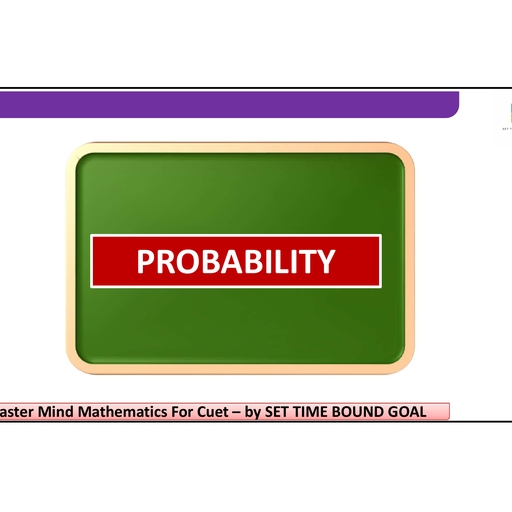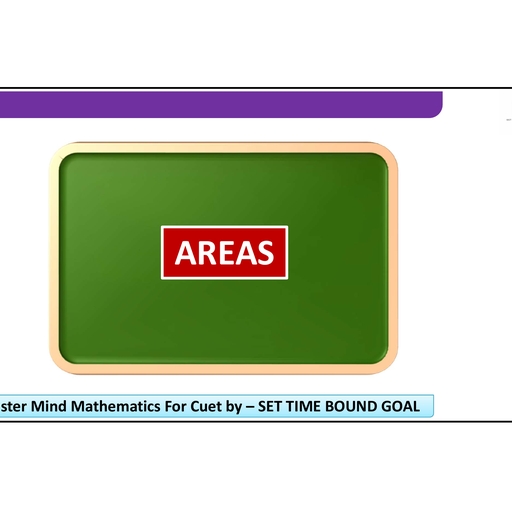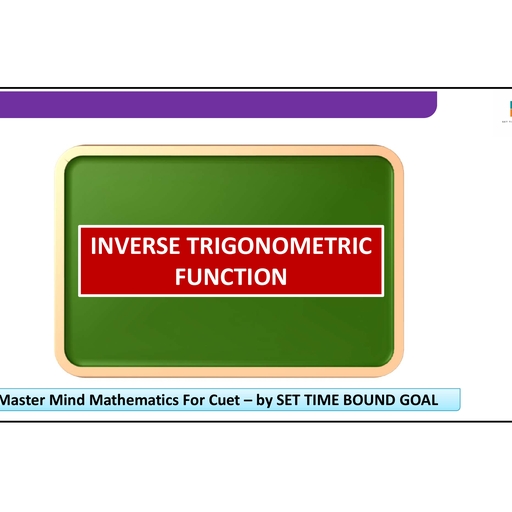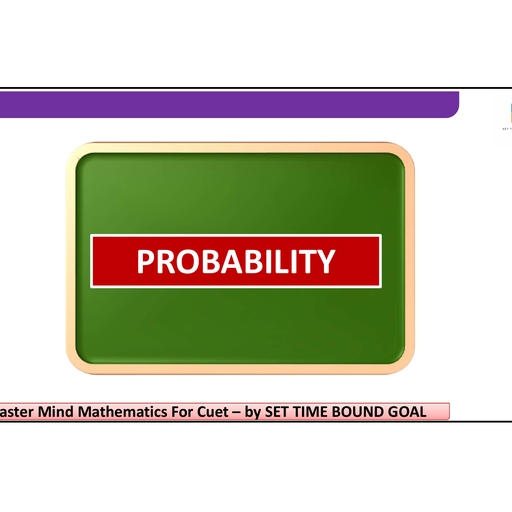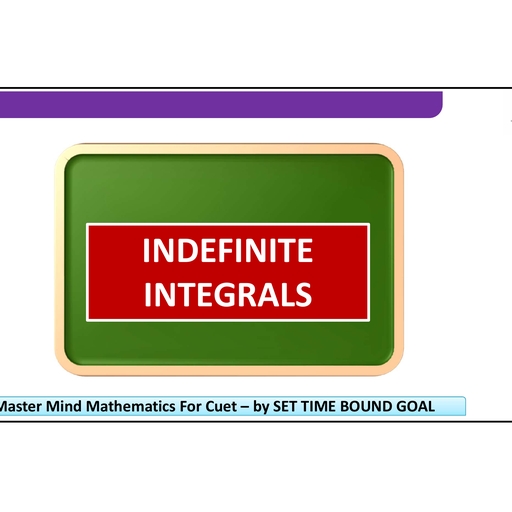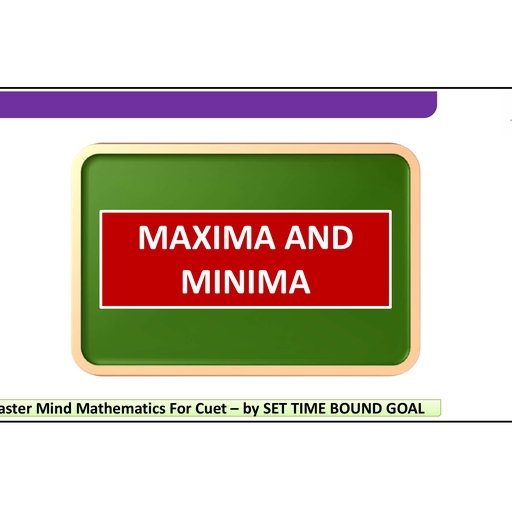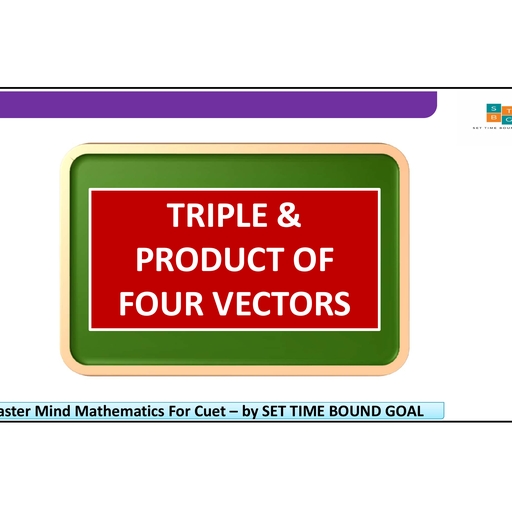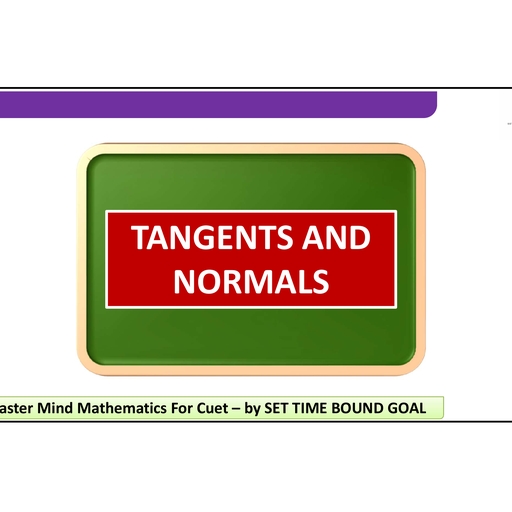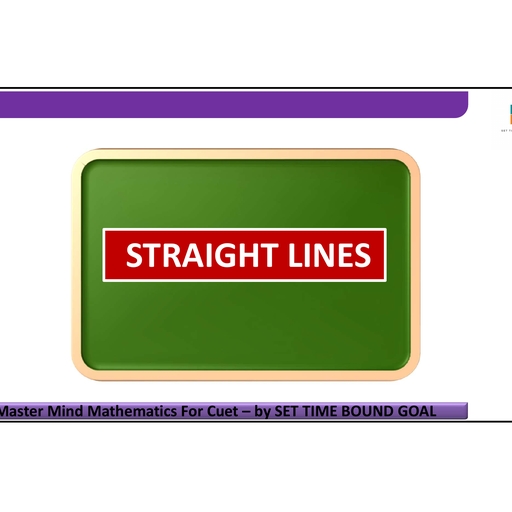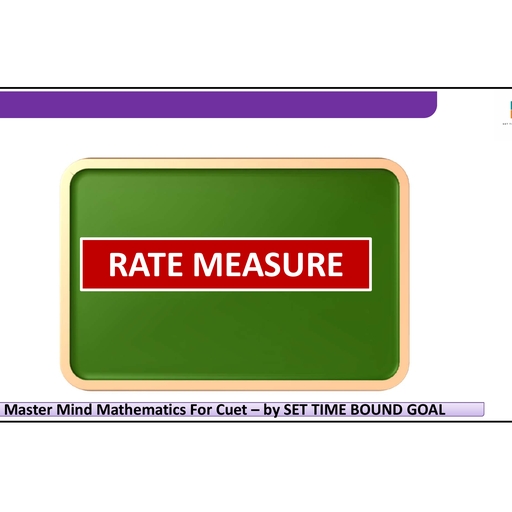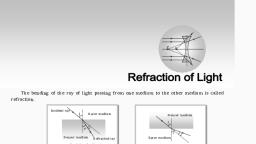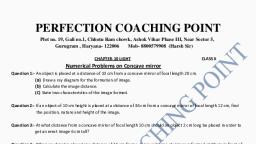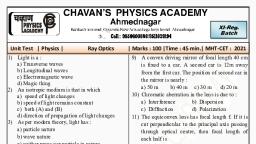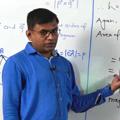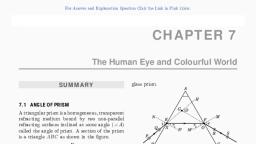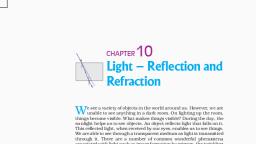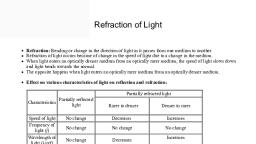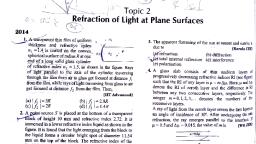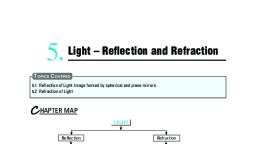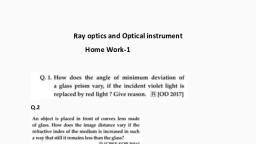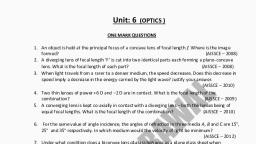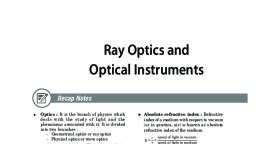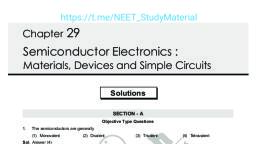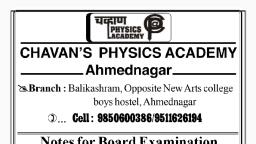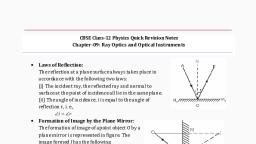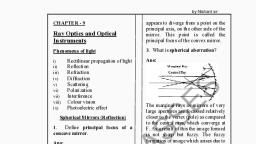Page 1 :
Refraction of Light 25, F, , F, , The bending of the ray of light passing from one medium to the other medium is called, refraction., Incident ray, , i, , Rarer medium, , Denser medium, i, , r, , , , r, Denser medium, , Refracted ray, , Deviation = (i – r), , Rarer medium, , , , Deviation = (r – i ), , Snell’s law, The ratio of sine of the angle of incidence to the angle of refraction (r) is a constant called, refractive index, i.e., , , sin i, sin i, (a constant). For two media, Snell's law can be written as 1 2 2 , 1 sin r, sin r, , 1 sin i 2 sin r i.e. sin constant, Also in vector form : ˆi nˆ μ (rˆ nˆ ), , Refractive Index., Refractive index of a medium is that characteristic which decides speed of light in it. It is a, scalar, unit less and dimensionless quantity., (1) Types : It is of following two types, Absolute refractive index, , Relative refractive index, , (i) When light travels from air to any, transparent medium then R.I. of medium w.r.t., , (i) When light travels from medium (1) to, medium (2) then R.I. of medium (2) w.r.t., medium (1) is called it’s relative R.I. i.e., 2 v1, , (where v1 and v2 are the speed of, 1 2 , 1 v 2, , air is called it’s absolute R.I. i.e. air medium , , c, v, , light in medium 1 and 2 respectively)., (ii) Some absolute R.I., a glass, , , , 3, 4, 1.5 , a water 1 .33, 3, 2, , (ii) Some relative R.I., (a) When light enters from water to glass :, g 3 / 2 9, , , w g , w 4 / 3 8
Page 2 :
26 Refraction of Light, a diamond, , a crown, , 2.4, a Cs 2 1.62, , (b) When light enters from glass to diamond :, g D, , 1.52 , vacuum 1 , air 1.0003 1, , Note : Cauchy’s equation :, , A, , B, , , , 2, , , , C, , 4, , ......, , , , D 2 .4 8, , , g 1 .5 5, , ( Red violet so Red violet ), , , , 1, , , 2 1 v 1 1, If a light ray travels from medium (1) to medium (2), then 1 2 , , , 1 2 v 2 v, v, (2) Dependence of Refractive index, , (i) Nature of the media of incidence and refraction., (ii) Colour of light or wavelength of light., (iii) Temperature of the media : Refractive index decreases with the increase in, temperature., (3) Principle of reversibility of light and refraction through several media :, Principle of reversibility, , Refraction through several media, , 1, , Incident ray, , 1, , i, , 2, r, 3, , 2, , 1, 1 2, , 1, , , 2, , 1, , 1 2, , 2 3 3 1 1, , Refraction Through a Glass Slab and Optical Path, (1) Lateral shift, The refracting surfaces of a glass slab are parallel to each other. When a light ray passes, through a glass slab it is refracted twice at the two parallel, i, faces and finally emerges out parallel to it's incident direction, rr , i.e. the ray undergoes no deviation = 0. The angle of, t, N, emergence (e) is equal to the angle of incidence (i), , M, , The Lateral shift of the ray is the perpendicular distance, between the incident and the emergent ray, and it is given by, MN = t sec r sin (i – r), , Normal shift, , O, , x, , O, ', , Glas, s, slab
Page 3 :
Refraction of Light 27, , Normal shift, , , 1, OO ' x 1 t, , , , Or the object appears to be shifted towards the slab by the distance x, , (2) Optical path :, It is defined as distance travelled by light in vacuum in the same time in which it travels a, given path length in a medium., , Light, , Time taken by light ray to pass through the medium , , x, c, , ;, , where x = geometrical path and x = optical path, x, , 1, , 2, , Light, , For two medium in contact optical path = 1 x 1 2 x 2, x1, , Note : , , x2, , Since for all media 1, so optical path length (x ) is always greater than, the geometrical path length (x)., , Real and Apparent Depth., If object and observer are situated in different medium then due to refraction, object, appears to be displaced from it’s real position. There are two possible conditions., (1) When object is in denser medium and, observer is in rarer medium, , (1) Object is in rarer medium and observer is in, denser medium., O d, O h, , h, h, , , O, , d, , (2) , , h, , O, , Real depth, h, ', Apparent depth h, , Real depth >Apparent depth that's why a, , (2) , , h', h, , Real depth < Apparent depth that's why high
Page 4 :
28 Refraction of Light, coin at the bottom of bucket (full of water), appears to be raised), , flying aeroplane appears to be higher than it's, actual height., , , 1, (3) Shift d h h ' 1 h, , , , , (3) d ( 1)h, , (4) For water , For glass , , 4, h, d , 3, 4, , (4) Shift for water d w , , 3, h, d , 2, 3, , Shift for glass d g , , h, 3, , h, 2, , Note : If a beaker contains various immisible liquids as shown then, Apparent depth of bottom , , combination =, , d1, , 1, , d AC, d d 2 ....., 1, d1 d 2, d App ., , ...., , 1, , , , d2, , 2, , , , d3, , 3, , ...., , 1, , d1, , 2, , d2, , 3, , d3, , (In case of two liquids if d 1 d 2 than , , 2, , 2 1 2, ), 1 2, , Total Internal Reflection., When a ray of light goes from denser to rarer medium it bends away from the normal and, as the angle of incidence in denser medium increases, the angle of refraction in rarer medium, also increases and at a certain angle, angle of refraction becomes 90 o, this angle of incidence is, called critical angle (C)., When Angle of incidence exceeds the critical angle than light ray comes back in to the same, medium after reflection from interface. This phenomenon is called Total internal reflection, (TIR)., Rarer, , r, , Denser, , 90o, , i, , , , i=C, , , , >C, , Important formula, , μ, , 1, cosec C ;, sin C, , where , , Rerer, , TIR, , Denser, , Note : When a light ray travels from denser to rarer medium, then deviation of the ray is, 2 max. when min. C, i.e. max ( 2C) ; C critical angle, , , , ,
Page 5 :
Refraction of Light 29, , (1) Dependence of critical angle, (i) Colour of light (or wavelength of light) : Critical angle depends upon wavelength as, 1, sin C, , , , (a) R V C R C V, (b) Sin C , media i sin 1, , 1, R D, , , , R D v D, (for two media), , , D R v R, , (c) For TIR from boundary of two, , R, D, , (ii) Nature of the pair of media : Greater the refractive index lesser will be the critical, angle., (a) For (glass- air) pair C glass 42 o, , (b) For (water-air) pair C water 49 o, , (c) For (diamond-air) pair C di amond 24 o, (iii) Temperature : With temperature rise refractive index of the material decreases therefore, critical angle increases., (2) Examples of total internal reflection (TIR), (i), , Rarer, , Dense, r i>C, , Sky, Rarer, , Mirage : An optical illusion in, deserts, , O, , Desne, r, , I, Earth, , I, , i>C, , O, , Earth, , Looming : An optical illusion in cold, countries, , (ii) Brilliance of diamond : Due to repeated internal reflections diamond sparkles., (iii) Optical fibre : Optical fibres consist of many long high quality composite glass/quartz, fibres. Each fibre consists of a core and cladding. The refractive index of the material of the, core (1) is higher than that of the cladding (2)., When the light is incident on one end of the fibre at a small angle, the light passes inside,, undergoes repeated total internal reflections along the fibre and finally comes out. The angle of, incidence is always larger than the critical angle of the core material with respect to its, cladding. Even if the fibre is bent, the light can, easily travel through along the fibre, A bundle of optical fibres can be used as a, 'light pipe' in medical and optical examination. It, can also be used for optical signal transmission., Optical fibres have also been used for transmitting, , 2, , Cladding, , 1, Core
Page 6 :
30 Refraction of Light, and receiving electrical signals which are converted to light by suitable transducers., (iv) Field of vision of fish (or swimmer) : A fish (diver) inside the water can see the, whole world through a cone with., (a) Apex angle 2C 98 o, (b) Radius of base r h tan C , , (c) Area of base A , , h 2, ( 2 1), , Note : For water, , , , r, , h, , 2 1, , C, h, , >C, , C C, , 9 h 2, 3h, 4, so r , and A , ., 7, 3, 7, , (v) Porro prism : A right angled isosceles prism, which is used in periscopes or binoculars., It is used to deviate light rays through 90 o and 180 o and also to erect the image., B, , 90o, 45o, 90o, , A, , B, , 45o, , A, , 90, , 45o 45o, 45o, , o, , 45o, 45o, , 45o, , 45o, , Concepts, , , , In case of refraction of light frequency (and hence colour) and phase do not change (while wavelength and, velocity will change)., , , , , In the refraction intensity of incident light decreases at it goes from one medium to another medium., , , , When a glass slab is kept over various coloured letters and seen from the top, the violet colour letters appears, , A transparent solid is invisible in a liquid of same refractive index (Because of No refraction)., , closer (Because v R so V R and from , , , if increases then h' decreases i.e. Letter appears to be, ', , closer), , , , Water drop in air and air bubble in water behaves as a lens., Ai, r, , Wate, r, , Like convex lens, , Example, s, , Ai, r, , Wate, r, , Ai, r, , Water, , Like concave lens
Page 7 :
Refraction of Light 31, , Example: 1, , A beam of monochromatic blue light of wavelength 4200 Å in air travels in water ( 4 / 3) ., Its wavelength in water will be, (a) 2800 Å, , 1, , [M, , (b) 5600 Å, , 1 2, , 2 1, , 2, 1, , 4, 4200, 3, , (c) 3150 Å, , (d) 4000 Å, , 2 3150 Å, , Solution: (c), , , , Example: 2, , On a glass plate a light wave is incident at an angle of 60o. If the reflected and the refracted, , , , , , , , , , waves are mutually perpendicular, the refractive index of material is, , [MP, , PMT 1994; Haryana CEE 1996], , (a), Solution: (b), , (b), , 3, , 3, 2, , (c), , From figure r 30 o, , , , Example: 3, , 3, 2, , (d), , 1, 3, , 60 60, °, °, 90, r °, , sin i sin 60 o, , , 3, sin r sin 30 o, , Velocity of light in glass whose refractive index with respect to air is 1.5 is 2 × 10 8 m / s and, in certain liquid the velocity of light found to be 2.50 10 8 m / s . The refractive index of the, liquid with respect to air is, [CPMT 1978; MP PET/PMT, 1988], , (a) 0.64, Solution: (c), Example: 4, , , , 1, v, , , , (b) 0.80, , (c) 1.20, , (d) 1.44, , li v g, , 2 10 8, , l , l 1 .2, g, vl, 1 .5 2 .5 10 8, , A ray of light passes through four transparent media with refractive indices 1 . 2 , 3 , and 4, as shown in the figure. The surfaces of all media are parallel. If the emergent ray CD is, parallel to the incident ray AB, we must have, (a) 1 2, (b) 2 3, (c) 3 4, (d) 4 1, , Solution: (d), , 1, , 2, , D, , 3, , 4, C, , B, A, , For successive refraction through difference media sin constant., Here as is same in the two extreme media. Hence 1 4, , Example: 5, , A ray of light is incident at the glass–water interface at an angle i, it emerges finally, parallel to the surface of water, then the value of g would be, (a) (4/3) sin i, , Water, , (b) 1/ sin i, (c) 4/ 3, , w=4/3, , r, r, , Glass, i, , [II
Page 8 :
32 Refraction of Light, (d) 1, Solution: (b), , For glass water interface, , g , , , , sin i, sin r, , ......(i), , and, , For water-air interface, , , , a , , sin r, sin 90, , .....(ii), , , Example: 6, , g , , a sin i, , g , , 1, sin i, , The ratio of thickness of plates of two transparent mediums A and B is 6 : 4. If light takes, equal time in passing through them, then refractive index of B with respect to A will be, (a) 1.4, , Solution: (b), , By using t , , , Example: 7, , (b) 1.5, , c, , B x A 6, , , , A xB 4, , A B, , , , 3, 1.5, 2, , A ray of light passes from vacuum into a medium of refractive index , the angle of, incidence is found to be twice the angle of refraction. Then the angle of incidence is, , By using , , (b) 2 cos1 / 2, sin 2r 2 sin r cos r, sin i, , , sin r, sin r, sin r, , , r cos 1 ., 2, Example: 8, , (d) 1.33, , x, , (a) cos1 / 2, Solution: (b), , (c) 1.75, , (d) 2 sin 1 / 2 , , (c) 2 sin 1 , ( sin 2 2 sin cos ), , , So, i 2r 2 cos 1 ., 2, , A ray of light falls on the surface of a spherical glass paper weight making an angle with, the normal and is refracted in the medium at an angle . The angle of deviation of the, emergent ray from the direction of the incident ray is, (a) , , Solution: (b), , (b) 2 , , (c) / 2, , (d) , , From figure it is clear that OBC is an isosceles triangle,, Hence OCB and emergent angle is , , , , Also sum of two in terior angles = exterior angle, , A, , ( ) 2 , Example: 9, , , –, , , –, , , C, , , , O, , D, , A rectangular slab of refractive index is placed over another slab of refractive index 3,, both slabs being identical in dimensions. If a coin is placed below the lower slab, for what, value of will the coin appear to be placed at the interface between the slabs when viewed, from the top, (a) 1.8, , Solution: (c), , B, , (b) 2, , Apparent depth of coin as seen from top , , , , 1, , 1, , , , 1, , 2, , 1, , 1 1, 1 1 .5, 3 , , (c) 1.5, , x, , 1, , , , x, , 2, , (d) 2.5, , x, 2 = , , x, , 1 = 3, , x, , [U
Page 9 :
Refraction of Light 33, Example: 10, , A coin is kept at bottom of an empty beaker. A travelling microscope is focussed on the coin, from top, now water is poured in beaker up to a height of 10 cm. By what distance and in, which direction should the microscope be moved to bring the coin again in focus, (a) 10 cm up ward, , Solution: (c), , (b) 10 cm down ward, , (c), , 2.5 cm up wards, , When water is poured in the beaker. Coin appears to shift by a distance d , , (d), , 2.5 cm do, , h 10, , 2.5 cm, 4, 4, , Hence to bring the coil again in focus, the microscope should be moved by 2.5 cm in upward, direction., Example: 11, , 4, , Consider the situation shown in figure. Water w is filled in a breaker upto a height, 3, , of 10 cm. A plane mirror fixed at a height of 5 cm from the surface of water. Distance of, image from the mirror after reflection from it of an object O at the bottom of the beaker is, (a) 15 cm, , Solution: (b), , (b) 12.5 cm, , (c) 7.5 cm, , From figure it is clear that object appears to be raised by, , (d) 10 cm, 10, cm 2 .5 cm , 4, , 5 cm, , Hence distance between mirror and O' 5 7.5 12 .5 cm, 10, 4, , So final image will be formed at 12.5 cm behind the plane mirror., c, , O, , m, , Example: 12, , 10, cm, , O', , The wavelength of light in two liquids 'x' and 'y' is 3500 Å and 7000 Å, then the critical angle, of x relative to y will be, (a) 60o, , (b) 45o, , (c) 30o, , (d) 15o, , 2 1 3500, 1, , , C 30 o, 1 2 7000, 2, , Solution: (c), , sin C , , Example: 13, , A light ray from air is incident (as shown in figure) at one end of a glass fiber (refractive, index = 1.5) making an incidence angle of 60 o on the lateral surface, so that it undergoes, a total internal reflection. How much time would it take to traverse the straight fiber of, length 1 km, [Orissa JEE 2002], Air, , (a) 3.33 sec, Air, , (b) 6.67 sec, , 60, o, , Glass, , (c) 5.77 sec, (d) 3.85 sec, Solution: (d), , When total internal reflection just takes place from lateral surface then i = C i.e. C = 60o, From , Hence, , time, 2, , t, Example: 14, , 1, 1, 2, , , sin 60, sin C, 3, , 3, , , , 1 10, 3 10 8, , taken, 3, , by, , light, , traverse, , some, , distance, , in, , medium, , , , t, , x, C, , 3 . 85 sec ., , A glass prism of refractive index 1.5 is immersed in water ( 4 / 3) . A light beam incident, normally on the face AB is totally reflected to reach the face BC if, , [CP, , B, , C, , , , A
Page 10 :
34 Refraction of Light, (a) sin 8 / 9, (b) 2 / 3 sin 8 / 9, (c) sin 2 / 3, (d) cos 8 / 9, Solution: (a), , From figure it is clear that, Total internal reflection takes place at AC, only if > C, , sin sin C, , , , sin , Example: 15, , 1, 9/8, , sin , , B, , 1, , sin , , , , A, , , , g, , 8, 9, , C, , When light is incident on a medium at angle i and refracted into a second medium at an, angle r, the graph of sin i vs sin r is as shown in the graph. From this, one can conclude that, (a) Velocity of light in the second medium is 1.73 times the velocity of light in the I medium, (b) Velocity of light in the I medium is 1.73 times the, velocity in the II medium, , sin, r, , (c) The critical angle for the two media is given by sin, 1, ic , 3, , 30o, sin, i, , 1, (d) sin ic , 2, Solution: (b, c) From graph tan 30 o , , Also from, Example: 16, , , , sin r, 1, , sin i 1 2, , 1, , sin C, , sin C , , , , 1 2, , 3 , , 1, Rarer Denser, , 2 v1, , 1 .73, 1 v 2, , sin C , , 1, 1 2, , , , 1, , , , v1 1.75 v 2, , ., , 3, , A beam of light consisting of red, green and blue colours is incident on a right angled, prism. The refractive indices of the material of the prism for the above red, green and blue, wavelength are 1.39, 1.44 and 1.47 respectively. The prism will, , (a) Separate part of red colour from the green and the blue, colours, (b) Separate part of the blue colour from the red and green, colours, , 45, °, , (c) Separate all the colours from one another, (d) Not separate even partially any colour from the other two colours, Solution: (a), , At face AB, i = 0 so r = 0, i.e., no refraction will take place. So light will be incident on face, AC at an angle of incidence of 45 o. The face AC will not transmit the light for which i C ,, i.e.,, or, , sin i sin C, , sin 45 o 1 / i.e., 2 ( 1 .41 ), , A, , 45°, 45°, B, , C
Page 11 :
Refraction of Light 35, Now as R while G and B , so red will be transmitted through the face AC while, green and blue will be reflected. So the prism will separate red colour from green and blue., Example: 17, , An air bubble in a glass slab 1.5 is 6 cm deep when viewed from one face and 4 cm, deep when viewed from the opposite face. The thickness of the glass plate is, (a) 10 cm, , Solution: (c), , (b) 6.67 cm, , (c) 15 cm, , (d) None of these, , Let thickness of slab be t and distance of air bubble from one side is x, When viewed from side (1) : 1.5 , , 6 cm, , x, x 9 cm, 6, , t 9 t 15 cm, (t x ), Side 1, When viewed from side (2) : 1.5 , 1.5 , 4, 4, , 4 cm, Air, bubbl, e, , x, , Side 2, , t, , Tricky example: 1, One face of a rectangular glass plate 6 cm thick is silvered. An object held 8 cm in, front of the first face, forms an image 12 cm behind the silvered face. The refractive, index of the glass is, [CPMT 1999], (a) 0.4, , (b) 0.8, , (c) 1.2, , (d) 1.6, , x, , Solution : (c) From figure thickness of glass plate t = 6 cm., Let x be the apparent position of the silvered surface., According to property of plane mirror, x + 8 = 12 + 6 – x, Also, , , , t, x, , , , , , , , Objec, t, , Image, , 8, cm, , x = 5 cm, , 6, 1.2, 5, , t, , 12, cm, 12 +(6–, x), , Tricky example: 2, A ray of light is incident on a glass sphere of refractive index 3/2. What should be the, angle of incidence so that the ray which enters the sphere doesn't come out of the, sphere, 2, (a) tan 1 , 3, , 2, (b) sin 1 , 3, , 1, (d) cos 1 , 3, , (c) 90o, , i, Solution : (c) Ray doesn't come out from the sphere means TIR takes place., , A, , Hence from figure ABO OAB C, , , , , , Tricky example: 3, , C, O, , 1, 2, 1, , sin C , 3, sin C, , Applying Snell's Law at A, , i 90 o, , B, C, , sin i 3, , sin C 2, , , , sin i , , 3, 3 2, sin C 1, 2, 2 3, ,
Page 12 :
36 Refraction of Light, , The image of point P when viewed from top of the slabs will be, (a) 2.0 cm above P, Solution: (d), , (b) 1.5 cm above P, , (c) 2.0 cm below P, , (d) 1 cm above P, , The two slabs will shift the image a distance, , 1, 1 , , d 2 1 t 2 1 , 1 .5 1 cm, , 1 .5 , , , , Therefore, final image will be 1 cm above point P., , Refraction From Curved Surface., , 1, O, , 1, , 2, , P, , I, , O, , 2, P, , I, , 1 Refractive index of the medium from which light rays are coming (from object)., , 2 Refractive index of the medium in which light rays are entering., , u = Distance of object, v = Distance of image, R = Radius of curvature, Refraction formula :, , 2 1, R, , , , 2, v, , , , 1, u, , (use sign convention while solving the problem), , Note : Real image forms on the side of a refracting surface that is opposite to the object,, and virtual image forms on the same side as the object., Lateral (Transverse) magnification m , , v, I, 1 ., O 2u, , Specific Example, In a thin spherical fish bowl of radius 10 cm filled with water of refractive index 4/3 there is a small, fish at a distance of 4 cm from the centre C as shown in figure. Where will the image of fish appears,, if seen from E, (a) 5.2 cm, , (b) 7.2 cm, , Solution : (a) By using, , where, , 2, v, , 1 , , , , 1, u, , 4, ,, 3, , On putting values, , , , (c) 4.2 cm, , (d) 3.2 cm, , 2 1, R, E, , C, , 2 1,, , u 6 cm, v = ?, , v 5.2 cm, , 4, cm
Page 13 :
Refraction of Light 37, , Lens., Lens is a transparent medium bounded by two refracting surfaces, such that at least one, surface is spherical., (1) Type of lenses, Convex lens (Converges the light rays), , Double convex, convex, , Plano convex, , Concave lens (Diverges the light rays), , Concavo, , Double concave, concave, , Plane concave, , Thick at middle, , Thin at middle, , It forms real and virtual images both, , It forms only virtual images, , Convexo, , (2) Some definitions, Optical axis, , C1, , C1, , C2, O, , C1, C2 – Centre of, curvature,, R1, R2 – Radii of, curvature, , C2, O, , Principl, e, axis, – R2, , +R1, , – R1 +R2, , (i) Optical centre (O) : A point for a given lens through which light ray passes undeviated, (Light ray passes undeviated through optical centre)., (ii) Principle focus, First principle focus, F1, , Second principle focus, , F1, , F2, , Note : Second principle focus is the principle focus of the lens., When medium on two sides of lens is same then | F1 | | F2 | ., , F2
Page 14 :
38 Refraction of Light, If medium on two sides of lens are not same then the ratio of two focal lengths, f1, , 1, f2 2, 1, , 2, , (iii) Focal length (f) : Distance of second principle focus from optical centre is called focal, length, fconvex positive, fconcave negative, fplane , , (iv) Aperture : Effective diameter of light transmitting area is called aperture., Intensity of image (Aperture), , 2, , (v) Power of lens (P) : Means the ability of a lens to converge the light rays. Unit of power, is Diopter (D)., 1, 100, , ; Pconvex positive, Pconcave negative, Pplane zero ., f (m ) f (cm), , P, , Note : , , Thick lens, PfR, , Thin lens, Pf R, , (3) Image formation by lens, Location of, the, object, , Lens, , Convex, , Location of the, image, , 2f, , virtual, , Erect, inverted, , Real, , Inverted, , m 1, diminished, , Real, , Inverted, , i.e. (u 2 f ), , Between f and 2f, i.e. f v 2 f, , At 2f or, , At 2f i.e. (v 2 f ), , m 1, same size, , Real, , Inverted, , Between f and, 2f, i.e. f u 2 f, , Away from 2f i.e., (v 2 f ), , m 1, magnified, , Real, , Inverted, , At focus, i.e. u f, , At infinity, i.e. v , , m, magnified, , Real, , Inverted, , (u 2 f ), f, , Real, , m 1, diminished, , Away from 2f, , f, , Magnificati, on, , At focus i.e. v f, , At infinity, i.e. u , , 2f, , Nature of image
Page 15 :
Refraction of Light 39, , Concave, , Between, optical centre, and focus,, u f, , At a distance, greater than that, of object v u, , m 1, magnified, , Virtual, , Erect, , At infinity, i.e. u , , At focus i.e. v = f, , m 1, diminished, , Virtual, , Erect, , Anywhere, between, infinity and, optical centre, , Between optical, centre and focus, , m 1, , Virtual, , Erect, , diminished, , Note : Minimum distance between an object and it’s real image formed by a convex lens is, 4f., Maximum image distance for concave lens is it’s focal length., (4) Lens maker’s formula, The relation between f, , R1 and R2 is known as lens maker’s formula and it is, , 1, 1, 1, ( 1), , f, R1 R 2, , , , , , Equiconvex lens, R1 R and R 2 R, f , , R, 2( 1), , Plano convex lens, R1 , R 2 R, f , , for 1 .5 , f R, , R, ( 1), , Equi concave lens, R1 R , R 2 R, f , , for 1 .5 , f 2 R, , R, 2( 1), , for 1 .5 f R, , Plano concave lens, R1 , R 2 R, f , , R, 2( 1), , for 1 .5, f 2 R, , (5) Lens in a liquid, Focal length of a lens in a liquid ( fl ) can be determined by the following formula, , f l ( a μ g 1), , f a ( l μ g 1), , (Lens is supposed to be made of glass)., , Note : Focal length of a glass lens, , ( 1 . 5 ) is f in air then inside the water it’s focal length, , is 4f., In liquids focal length of lens increases () and it’s power decreases ()., (6) Opposite behaviour of a lens, In general refractive index of lens ( L ) refractive index of medium surrounding it ( M ) ., , L > M, , L < M, , L = M
Page 16 :
40 Refraction of Light, , (7) Lens formula and magnification of lens, (i) Lens formula :, , 1 1 1, ; (use sign convention), f v u, , (ii) Magnification : The ratio of the size of the image to the size of object is called, magnification., (a) Transverse magnification : m , , I, v, f, f v, , , O u, f u, f, , (use sign convention while solving, , the problem), (b), , Longitudinal, 2, , m, , 2, , magnification, , f , f v, dv v , , , , du u , f u, f , , :, , m, , I v 2 v1, , ., O u 2 u1, , For, , very, , small, , object, , 2, , 2, , A, f , ,, (c) Areal magnification : m s i m 2 , Ao, f u, , (Ai = Area of image, Ao = Area of object), , (8) Relation between object and image speed, If an object move with constant speed (Vo ) towards a convex lens from infinity to focus, the, 2, , f , . Vo, image will move slower in the beginning and then faster. Also Vi , f u, , (9) Focal length of convex lens by displacement method, (i) For two different positions of lens two images (I1 and I 2 ) of an object is formed at the, same location., (ii) Focal length of the lens f , where m 1 , , I1, I, and m 2 2, O, O, , (iii) Size of object O I1 . I 2, , D2 x 2, x, , 4D, m1 m 2, , x, Object, O, , I2, D > 4f, , I1, Screen
Page 17 :
Refraction of Light 41, , (10) Cutting of lens, (i) A symmetric lens is cut along optical axis in two equal parts. Intensity of image formed, by each part will be same as that of complete lens., (ii) A symmetric lens is cut along principle axis in two equal parts. Intensity of image, formed by each part will be less compared as that of complete lens.(aperture of each part is, , 1, 2, , times that of complete lens), f, P, , , , , 2f, , f, P, , 2f, , f, P, , P/2 P/2, , (11) Combination of lens, (i) For a system of lenses, the net power, net focal length and magnification given as, follows :, , 1, 1, 1, 1, , , .......... . ,, F f1 f2 f3, , P P1 P2 P3 .......... ,, , m m 1 m 2 m 3 .......... .., , (ii) In case when two thin lens are in contact : Combination will behave as a lens, which, have more power or lesser focal length., , 1 1, 1, , , , F f1 f2, , F, , f1 f2, f1 f2, , P P1 P2, , and, , (iii) If two lens of equal focal length but of opposite nature are in contact then combination, will behave as a plane glass plate and Fcombinatio n , (iv) When two lenses are placed co-axially at a distance d from each other then equivalent, focal length (F)., f2, , f1, , 1, 1, 1, d, , , F f1 f2 f1 f2, , and, , P P1 P2 dP1 P2, d, , (v) Combination of parts of a lens :, , and, , , , and, , F = f/2, f, , f, , F, , =f, , F=f, , F=
Page 18 :
42 Refraction of Light, , (12) Silvering of lens, On silvering the surface of the lens it behaves as a mirror. The focal length of the silvered, lens is, , 1, 2, 1, , , F fl, fm, , where fl focal length of lens from which refraction takes place (twice), fm focal length of mirror from which reflection takes place., , (i) Plano convex is silvered, , , , +, , F, , fm , , , fm, , fl, , R, R, R, so F , , fl , ( 1), 2, 2, , F, , +, fl, , fm , fl , , fm, , R, R, so F , 2 ( 1), ( 1), , (ii) Double convex lens is silvered, , Since fl , , R, R, , fm , 2 ( 1), 2, , So F , , R, , , , F, , +, , fl, , fm, , 2 (2 1), , Note : Similar results can be obtained for concave lenses., (13) Defects in lens, (i) Chromatic aberration : Image of a white object is coloured and blurred because , (hence f) of lens is different for different colours. This defect is called chromatic aberration., White, light, , Real Violet, FV, , FR, , V R so fR fV, Mathematically chromatic aberration = f R fV ωfy, , = Dispersion power of lens., , fV, fR, , fy = Focal length for mean colour , , f R fV, , Removal : To remove this defect i.e. for Achromatism we use two or more lenses in contact in, place of single lens.
Page 19 :
Refraction of Light 43, , 1, , Mathematically condition of Achromatism is :, , f1, , , , 2, f2, , 0 or 1 f2 2 f1, , Note : , , Component lenses of an achromatic doublet cemented by canada blasam, because it is transparent and has a refractive index almost equal to the refractive, of the glass., (ii) Spherical aberration : Inability of a lens to form the point image of a point object on, the axis is called Spherical aberration., In this defect all the rays passing through a lens are not focussed at a single point and the, image of a point object on the axis is blurred., Marginal, rays, Paraxial ray, , F, , F, , F, , F, , Removal : A simple method to reduce spherical aberration is to use a stop before and, infront of the lens. (but this method reduces the intensity of the image as most of the light is cut, off). Also by using plano-convex lens, using two lenses separated by distance d = F – F ', using, crossed lens., , Note : , , Marginal rays : The rays farthest from the principal axis., , Paraxial rays : The rays close to the principal axis., Spherical aberration can be reduced by either stopping paraxial rays or marginal, rays, which can be done by using a circular annular mask over the lens., Parabolic mirrors are free from spherical aberration., (iii) Coma : When the point object is placed away from the principle axis and the image is, received on a screen perpendicular to the axis, the shape of the image is like a comet. This, defect is called Coma., It refers to spreading of a point object in a plane to principle axis., Image of P, , P, , , , Axis, P, , Removal : It can be reduced by properly designing radii of curvature of the lens surfaces. It, can also be reduced by appropriate stops placed at appropriate distances from the lens., (iv) Curvature : For a point object placed off the axis, the image is spread both along and, perpendicular to the principal axis. The best image is, in general, obtained not on a plane but on, a curved surface. This defect is known as Curvature., Removal : Astigmatism or the curvature may be reduced by using proper stops placed at, proper locations along the axis.
Page 20 :
44 Refraction of Light, (v) Distortion : When extended objects are imaged, different portions of the object are in, general at different distances from the axis. The magnification is not the same for all portions, of the extended object. As a result a line object is not imaged into a line but into a curve., , Object, , Distorted images, , (vi) Astigmatism : The spreading of image (of a point object placed away from the, principal axis) along the principal axis is called Astigmatism., Concepts, , , , If a sphere of radius R made of material of refractive index 2 is placed in a medium of refractive index 1 ,, 1 , R from the pole, the real image formed is equidistant from, Then if the object is placed at a distance , , 2 1 , the sphere., 1, 2, O, , P1, , P2 I, , 2, x, , x, , 2x, , , , The lens doublets used in telescope are achromatic for blue and red colours, while these used in camera are, achromatic for violet and green colours. The reason for this is that our eye is most sensitive between blue and, red colours, while the photographic plates are most sensitive between violet and green colours., , , , Position of optical centre, Equiconvex and equiconcave, , Exactly at centre of lens, , Convexo-concave and concavo-convex, , Outside the glass position, , Plano convex and plano concave, , , , Composite lens : If a lens is made of several materials then, Number of images formed = Number of materials used, , On the pole of curved surface, , 1, 2, 3, 4, 5, , Here no. of images = 5, , Example, s, Example: 18, , A thin lens focal length f1 and its aperture has diameter d. It forms an image of intensity I., Now the central part of the aperture upto diameter d/2 is blocked by an opaque paper. The, focal length and image intensity will change to
Page 21 :
Refraction of Light 45, (a), Solution: (d), , Example: 19, , I, f, and, 2, 2, , (b) f and, , I, 4, , (c), , 3f, I, and, 4, 2, , (d) f and, , 3I, 4, , , 1, d 2 , d, is blocked i.e., ., th area is blocked A , , 4, 4 , 2, , I A 3, 3, Hence remaining area A A . Also, we know that intensity Area , , , , I, A, 4, 4, 3, I I ., 4, Focal length doesn't depend upon aperture., The power of a thin convex lens (a g 1 . 5) is + 5.0 D. When it is placed in a liquid of, Centre part of the aperture up to diameter, , refractive index a l , then it behaves as a concave lens of local length 100 cm. The, refractive index of the liquid a l will be, (a) 5 / 3, Solution: (a), , By using, , , (b) 4 / 3, fl, , fa, , a g 1, l g 1, , 100, 1 .5 1, , , 1 .5, 20, 1, , ; where, , l g, , (c), , , g, l, , , , 1 .5, , l, , (d) 5 / 4, , 3, , and fa , , 1 1, m 20 cm, P 5, , l 5 / 3, , l, , Example: 20, , A double convex lens made of a material of refractive index 1.5 and having a focal length of, 10 cm is immersed in liquid of refractive index 3.0. The lens will behave as, (a) Diverging lens of focal length 10 cm, , (b) Diverging lens of focal length 10 / 3 cm, , (c) Converging lens of focal length 10 / 3 cm, length 30 cm, , fl, , fa, , a g, , 1, , l g, , 1, , , , (d), , Converging lens of focal, , fl, 1.5 1, fl 10 cm, , 1.5, 10, 1, 3, , Solution: (a), , By using, , Example: 21, , Figure given below shows a beam of light converging at point P. When a concave lens of, focal length 16 cm is introduced in the path of the beam at a place O shown by dotted line, such that OP becomes the axis of the lens, the beam converges at a distance x from the lens., The value x will be equal to, , (i.e. diverging lens), , [AMU (Med.) 2002], , (a) 12 cm, P, , (b) 24 cm, 12 cm, , O, , (c) 36 cm, (d) 48 cm, Solution: (d), , From the figure shown it is clear that, For lens : u = 12 cm and v = x = ?, By using, , P', , 1 1 1, , f v u, x, , 1, 1, 1, , , 16, x 12, , x = 48 cm., , 12cm, , P, , [N
Page 22 :
46 Refraction of Light, Example: 22, , A convex lens of focal length 40 cm is an contact with a concave lens of focal length 25 cm., The power of combination is, (a) – 1.5 D, , Solution: (a), , Example: 23, , 1, 1, 1, , , F, f1, f2, , By using, , , (b) – 6.5 D, , F, , (c) + 6.5 D, , [II, , (d) + 6.67 D, , 1, 1, 1, , , F 40 25, , , , 200, cm , hence, 3, , P, , 100, 100, , 1 .5 D, f (cm) 200 / 3, , A combination of two thin lenses with focal lengths f1 and f2 respectively forms an image, of distant object at distance 60 cm when lenses are in contact. The position of this image, shifts by 30 cm towards the combination when two lenses are separated by 10 cm. The, corresponding values of f1 and f2 are, [AIIMS 1995], (a) 30 cm, – 60 cm, , Solution: (b), , (b) 20 cm, – 30 cm, , (c) 15 cm, – 20 cm, , (d) 12 cm, – 15 cm, , Initially F 60 cm (Focal length of combination), Hence by using, , 1, 1, 1, , , F, f1, f2, , Finally by using, , 1, 1, 1, d, , , , F f1, f2, f1 f2, , , , 1, 1, 1, , , f1, f2, 60, , , , where F 30 cm and d = 10 cm, , f1 f 2, f1 f 2, , , , ..., , 1, 1, 1, 10, , , , ......(ii), 30, f1, f2, f1 f2, , From equations (i) and (ii) f1 f2 600 ., , f1 f2 10, , From equation (i), , …..(iii), , Also, difference of focal lengths can written as f1 f2 ( f1 f2 ) 2 4 f1 f2, , f1 20 and f2 30, , From (iii) (iv), Example: 24, , f1 f2 50 …..(iv), , A thin double convex lens has radii of curvature each of magnitude 40 cm and is made of, glass with refractive index 1.65. Its focal length is nearly, (a) 20 cm, , (b) 31 cm, R, , 2 1, , (c) 35 cm, , (d) 50 cm, , 40, 30 .7 cm 31 cm., 21.65 1, , Solution: (b), , By using f , , Example: 25, , A spherical surface of radius of curvature R separates air (refractive index 1.0) from glass, (refractive index 1.5). The centre of curvature is in the glass. A point object P placed in air, is found to have a real image Q in the glass. The line PQ cuts the surface at a point O and, PO OQ . The distance PO is equal to, , f , , [MP PMT 1994;, 1996], , (a) 5 R, Solution: (a), , By using, Where, , (b) 3 R, , 2, v, , , , 1 1,, , 1, u, , , , (c) 2 R, , (d) 1.5 R, , 2 1, R, , 2 1.5,, , u = – OP,, , v = OQ, P, , O, , Q, , Haryana CEE, , [M
Page 23 :
Refraction of Light 47, , 1.5, 1, 1 .5 1, , , , R , OQ OP, , Hence, , 1 .5, 1, 0 .5, , , OP OP, R, , OP = 5 R, Example: 26, , The distance between an object and the screen is 100 cm. A lens produces an image on the, screen when placed at either of the positions 40 cm apart. The power of the lens is, (a) 3 D, , Solution: (b), , (b) 5 D, , By using, , f , , D x, 4D, 2, , Hence power P , Example: 27, , 2, , f , , (c) 7 D, , 100 40, 4 100, 2, , 2, , [SC, , (d) 9 D, , 21 cm, , 100, 100, , 5D, Fcm , 21, , Shown in figure here is a convergent lens placed inside a cell filled with a liquid. The lens, has focal length +20 cm when in air and its material has refractive index 1.50. If the liquid, has refractive index 1.60, the focal length of the system is, Liquid, , (a) + 80 cm, , Lens, , (b) – 80 cm, (c) – 24 cm, (d) – 100 cm, Solution: (d), , Here, , 1, 1 3, 1, 1 . 6 1 , , f1, 20 100, , .......(i), , 1, 1 , 1, 1, 1 . 5 1 , , , f2, 20, , 20, 20, , , , .......(ii), , 1, 1 3, 1, 1 . 6 1 , , f3, 20 100, , .......(iii), , By using, Example: 28, , Solution: (a), , 1, 1, 1, 1, , , , , F, f1, f2, f3, , f1, , F, , +, , f2, , f3, , 1, 3, 1, 3, F 100 cm, , , , F 100 20 100, , (a) Convex mirror of focal length 10 cm, , (b) Concave mirror of focal length 40 cm, , (c) Concave mirror of focal length 60 cm, , (d) Concave mirror of focal length 10 cm, , By using, , [SCRA 1998, , 1, 2, 1, , , F, fl, fm, , fm , , F, , , , fl, 20, , 10 cm, 2, 2, , (After silvering concave lens behave as convex mirror), , Solution: (a), , +, , A concave lens of focal length 20 cm placed in contact with a plane mirror acts as a, , Since, , Example: 29, , , , F, , +, , Fe, , Fm, , A candle placed 25 cm from a lens, forms an image on a screen placed 75 cm on the other, end of the lens. The focal length and type of the lens should be, (a) + 18.75 cm and convex lens, (b) – 18.75 cm and concave lens, (c) + 20.25 cm and convex lens, (d) – 20.25 cm and concave lens, In concave lens, image is always formed on the same side of the object. Hence the given, lens is a convex lens for which u = – 25 cm,, v = 75 cm., , [K
Page 24 :
48 Refraction of Light, 1 1 1, 1, 1, 1, , , , , f v u, f 75 25 , , By using, Example: 30, , f = + 18.75 cm., , A convex lens forms a real image of an object for its two different positions on a screen. If, height of the image in both the cases be 8 cm and 2 cm, then height of the object is, [KCET (Engg./Med.) 2000,, (a) 16 cm, , (b) 8 cm, O, , (c) 4 cm, , (d) 2 cm, , O 8 2 4 cm, , Solution: (c), , By using, , Example: 31, , A convex lens produces a real image m times the size of the object. What will be the, distance of the object from the lens, , I1 I 2, , m 1, (a) , f, m , , m 1, (c) , f, m , , (b) (m 1) f, , f, f u, , f , f u, , , , 1, f u, u, , 1, m, f, f, , m 1, f, , (d), , m 1, u , . f, m , , Solution: (a), , By using m , , Example: 32, , An air bubble in a glass sphere having 4 cm diameter appears 1 cm from surface nearest to, eye when looked along diameter. If a g 1.5 , the distance of bubble from refracting surface, , here m , , is, , [CPMT 2002], , (a) 1.2 cm, Solution: (a), , (b) 3.2 cm, , v, , , , 1, u, , , , (d) 1.6 cm, 2=1, , 2 1, , 1=1.5, , R, , where u = ? , v = – 1 cm,, , 1, 1.5 1 1.5, , , 2 , 1, u, , 1 1.5 ,, , 2 1 , R = – 2 cm., , C, u, , 6, u 1 .2 cm., 5, , v =1cm, R = 2cm, , The sun's diameter is 1 .4 10 9 m and its distance from the earth is 10 11 m . The diameter of its, image, formed by a convex lens of focal length 2m will be, (a) 0.7 cm, image), , Solution: (c), , (c) 2.8 cm, , By using, , 2, , Example: 33, , , , (b) 1.4 cm, , (c) 2.8 cm, , (d) Zero, , From figure, , D 10 11, , d, 2, , d , , (i.e., , point, , f, , 2 1 . 4 10 9, 10 11, , Sun, (D), , 2 . 8 cm., , , , , , 1011 m, , Example: 34, , (d), Imag, e, , Two point light sources are 24 cm apart. Where should a convex lens of focal length 9 cm be, put in between them from one source so that the images of both the sources are formed at, the same place, (a) 6 cm, , Solution: (a), , [JI, , (b) 9 cm, , (c) 12 cm, , (d) 15 cm, , The given condition will be satisfied only if one source (S1) placed on one side such that u <, f (i.e. it lies under the focus). The other source (S2) is placed on the other side of the lens, such that u > f (i.e. it lies beyond the focus)., , [M
Page 25 :
Refraction of Light 49, If S 1 is the object for lens then, , 1, 1, 1, 1 1 1, , , , y x f, f y x, , If S 2 is the object for lens then, , 1, 1 1, 1, 1, 1, ........(ii), , , , f y (24 x ), y, f (24 x ), , ........(i), , I1, , From equation (i) and (ii), , 1, 1 1 1, 1, 2 2, 1, , x 2 24 x 108 0, , x (24 x ) f 9, x f, f (24 x ), , S1, , I2, x, 24 cm, , On solving the equation x 18 cm , 6 cm, Example: 35, , There, a w, , (24 –, 4), , y, , is an equiconvex glass lens with radius of each face as R and, , a g, , 3 / 2 and, , 4 / 3 . If there is water in object space and air in image space, then the focal length is, , (a) 2R, Solution: (c), , S2, , (b) R, , (d) R 2, , (c) 3 R/2, , Consider the refraction of the first surface i.e. refraction from rarer medium to denser, medium, , 2 1, R, , , , 1, u, , , , 2, v1, , 3 4 4, 3, , 2 3, 3, , 2 v1 9 R, , R, v1, , I, , Now consider the refraction at the second surface of the lens, i.e. refraction from denser medium to rarer medium, , I1, , Air, , Wate, r, , 3, 3, 2 2 1 v 3 R, 2, R, 9R v2, 2, , 1, , The image will be formed at a distance do, , 3, R . This is equal to the focal length of the lens., 2, , Tricky example: 4, A luminous object is placed at a distance of 30 cm from the convex lens of focal length, 20 cm. On the other side of the lens. At what distance from the lens a convex mirror, of radius of curvature 10 cm be placed in order to have an upright image of the object, coincident with it, [CBSE PMT 1998; JIPMER 2001, 2002], , (a) 12 cm, , (b) 30 cm, , Solution : (c) For lens u 30 cm, f 20 cm , hence by using, , (c) 50 cm, , (d) 60 cm, , 1, 1, 1, 1 1 1, , v 60 cm, , 20 v 30, f v u, I, , The final image will coincide the object, if light ray falls Onormally, on convex mirror as shown. From figure it is seen clear that, 30 cm, , reparation between lens and mirror is 60 – 10 = 50 cm., , 10 cm, 60 cm
Page 26 :
50 Refraction of Light, Tricky example: 5, A convex lens of local length 30 cm and a concave lens of 10 cm focal length are, placed so as to have the same axis. If a parallel beam of light falling on convex lens, leaves concave lens as a parallel beam, then the distance between two lenses will be, (a) 40 cm, , (b) 30 cm, , (c) 20 cm, , (d) 10 cm, , Solution : (c) According to figure the combination behaves as plane glass plate (i.e., F= ), Hence by using, , , 1, 1, 1, d, , , , F, f1, f2, f1 f2, , 1, 1, 1, d, d = 20 cm, , , , 30 10 30 10 , , Prism, Prism is a transparent medium bounded by refracting surfaces, such that the incident, surface (on which light ray is incidenting) and emergent surface (from which light rays, emerges) are plane and non parallel., Commonly used prism :, , Right angled isosceles, prism, , Right angle, prism, , Equilateral, prism, , (1) Refraction through a prism, A r1 r2 and i e A , , A, A, i, , r1, , , , e, , r2, , , B, , C, , i – Angle of incidence, e – Angle of, , For surface AC , , sin i, ; emergence,, sin r1 A – Angle of prism or refracting angle, , For surface AB , , sin r2, sin e, , of prism,, r1 and r2 – Angle of refraction,, – Angle of deviation, , (2) Deviation through a prism, For thin prism ( 1) A . Also deviation is different for different colour light e.g. R V, so R V ., , Flint Crown so F C, Maximum deviation, , Minimum deviation, , ma, , i=, r =C, 90o 1, , It is observed if, , e, , x, , r2, , i, , r, , r, , e, , i e and r1 r2 r
Page 27 :
Refraction of Light 51, then :, , In this condition of maximum deviation i 90 o ,, , r1 C,, , r2 A C, , and, , from, , Snell’s, , law, , (i) Refracted ray inside the prism is parallel to, the base of the prism, , on, , sin( A C) , emergent surface e sin 1 , , sin C , , (ii) r , , A m, A, and i , 2, 2, , sin i, (iii) , or , sin A / 2, , Note : , , A m, 2, sin A / 2, , sin, , If m A then 2 cos A / 2, , (3) Normal incidence on a prism, If light ray incident normally on any surface of prism as shown, , i = 0o, r1 = 0o, , e = 0o, r2, , and, , e, , In any of the above case use , , i, , r1, , r2 =, 0o, , or, , sin i, and i A, sin A, , (4) Grazing emergence and TIR through a prism, When a light ray falls on one surface of prism, it is not necessary that it will exit out from, the prism. It may or may not be exit out as shown below, Normal incidence, Ray –1 : General, emergence, A < C and, < cosec A, , A, , Ray - 3, Ray - 2, , Ray - 1, , Ray – 2: Grazing emergence, A = C and, = cosec A, Ray – 3: TIR, A > C and, > cosec A, , A = angle of prism and C = Critical angle for the, material of the prism, , Grazing incidence, Ray –1 : General, emergence, A < 2C and, < cosec (A/2), , A, , Ray – 2: Grazing emergence, A = 2C and, Ray - 1, = cosec (A/2), Ray – 3: TIR, Ray - 2, A > 2C and, > cosec (A/2), , Ray - 3
Page 28 :
52 Refraction of Light, , Note, , :, , , , For the condition of, , grazing emergence. Minimum, , angle of, , incidence, , i min sin 1 μ 2 1 sinA cosA ., , , (5) Dispersion through a prism, The splitting of white light into it’s constituent colours is called dispersion of light., Screen, R, Y, , Incident, white light, , V, , (i) Angular dispersion ( ), : Angular separation between extreme colours i.e., θ δ V δ R (μ V μ R ) A . It depends upon and A., (ii) Dispersive power () : , , R, , V, y, y 1, , R , , wher e y V, , 2, , , , It depends only upon the material of the prism i.e. and it doesn't depends upon angle of, prism A, , Note : Remember Flint Crown ., (6) Combination of prisms, Two prisms (made of crown and flint material) are combined to get either dispersion only, or deviation only., Dispersion without deviation, Flint, combination), V, R, , A, , (chromatic, , Deviation without, combination), , (Achromatic, , Flint, , A, , R, , R, V, , A, , V, , Crow, n, , (i), , dispersion, , ( y 1), A', , A, ( ' y 1), , ' , , (ii) net 1 ( ' ' ), , , , A, , Crow, n, , (i), , ( R ), A', V, A, ( ' V ' R ), , , , (ii) net 1 , ' , , , Scattering of Light, Molecules of a medium after absorbing incoming light radiations, emits them in all, direction. This phenomenon is called Scattering.
Page 29 :
Refraction of Light 53, , (1) According to scientist Rayleigh : Intensity of scattered light , , 1, , 4, , (2) Some phenomenon based on scattering : (i) Sky looks blue due to scattering., (ii) At the time of sunrise or sunset it looks reddish. (iii) Danger signals are made from red., (3) Elastic scattering : When the wavelength of radiation remains unchanged, the, scattering is called elastic., (4) Inelastic scattering (Raman’s effect) : Under specific condition, light can also suffer, inelastic scattering from molecules in which it’s wavelength changes., , Rainbow, Rainbow is formed due to the dispersion of light suffering refraction and TIR in the, droplets present in the atmosphere., (1) Primary rainbow : (i) Two refraction and, one TIR. (ii) Innermost arc is violet and outermost, is red. (iii) Subtends an angle of 42 o at the eye of the, observer. (iv) More bright, , Red, Violet, , (2) Secondary rainbow : (i) Two refraction, and two TIR. (ii) Innermost arc is red and, outermost is violet., , 42o40o, , (iii) It subtends an angle of 52.5 o at the eye. (iv), Comparatively less bright., , Colours, Colour is defined as the sensation received by the eye (rod cells of the eye) due to light, coming from an object., (1) Types of colours, Spectral colours, , Colours of pigment and dyes, , Green (P), , Cyan (S), , Yellow, (P), , Yellow (S), , Green (S), , white, , Black, Red (P), , Blue (P), Magenta (S), , (i) Complementary colours :, , Orange (S), , Blue (P), , Red (P), Radish violet, (S), (Mauve), , (i) Complementary colours :
Page 30 :
54 Refraction of Light, Green and magenta, , yellow and mauve, , Blue and yellow, , Red and green, , Red and cyan, , Blue and orange, , (ii) Combination :, , (ii) Combination :, , Green + red + blue = White, , Yellow + red + blue = Black, , Blue + yellow = White, , Blue + orange = Black, , Red + cyan = White, , Red + green = Black, , Green + magenta = White, , Yellow + mauve = Black, , (2) Colours of object : The perception of a colour by eye depends on the nature of object, and the light incident on it., Colours of opaque object, , Colours of transparent object, , (i) Due to selective reflection., , (i) Due to selective transmission., , (ii) A rose appears red in white light because it, reflects red colour and absorbs all remaining, colours., , (ii) A red glass appears red because it absorbs, all colours, except red which it transmits., , (iii) When yellow light falls on a bunch of, , (iii) When we look on objects through a green, , flowers, then yellow and white flowers looks, yellow. Other flowers looks black., , glass or green filter then green and white, objects will appear green while other black., , Note : A hot object will emit light of that colour only which it has observed when it was, heated., , Spectrum., The ordered arrangements of radiations according to wavelengths or frequencies is called, Spectrum. Spectrum can be divided in two parts (I) Emission spectrum and (II) Absorption, spectrum., (1) Emission spectrum : When light emitted by a self luminous object is dispersed by a, prism to get the spectrum, the spectrum is called emission spectra., , Continuous emission, spectrum, , Line emission spectrum, , (i) It consists of continuously, varying wavelengths in a, definite wavelength range., , (i) It consist of distinct bright, lines., , (iii) It consist, bright bands., , (ii) It is produced by solids,, liquids and highly compressed, gases, heated, to, high, temperature., , (ii) It is produced by an, excited source in atomic state., , (ii) It is produced by an, excited source in molecular, state., , (iii) e.g. Light from the sun,, , (iii) e.g. Spectrum of excited, , (iii) e.g. Spectra of molecular, , Band emission spectrum, of, , district
Page 31 :
Refraction of Light 55, filament of incandescent bulb,, candle flame etc., , helium,, mercury, vapours,, sodium vapours or atomic, hydrogen., , H 2 , CO, NH 3 etc., , (2) Absorption spectrum : When white light passes through a semi-transparent solid, or, liquid or gas, it’s spectrum contains certain dark lines or bands, such spectrum is called, absorption spectrum (of the substance through which light is passed)., (i) Substances in atomic state produces line absorption spectra. Polyatomic substances such, as H 2 , CO 2 and KMnO 4 produces band absorption spectrum., (ii) Absorption spectra of sodium vapour have two (yellow lines) wavelengths D1 (5890 Å), and D2 (5896 Å), , Note, , : If a substance emits spectral lines at high temperature then it absorbs the same, lines at low temperature. This is Kirchoff’s law., , (3) Fraunhoffer’s lines : The central part (photosphere) of the sun is very hot and emits, all possible wavelengths of the visible light. However, the outer part (chromosphere) consists of, vapours of different elements. When the light emitted from the photosphere passes through the, chromosphere, certain wavelengths are absorbed. Hence, in the spectrum of sunlight a large, number of dark lines are seen called Fraunhoffer lines., (i) The prominent lines in the yellow part of the visible spectrum were labelled as D-lines,, those in blue part as F-lines and in red part as C-line., (ii) From the study of Fraunhoffer’s lines the presence of various elements in the sun’s, atmosphere can be identified e.g. abundance of hydrogen and helium., (4) Spectrometer : A spectrometer is used for obtaining pure spectrum of a source in, laboratory and calculation of of material of prism and of a transparent liquid., It consists of three parts : Collimator which provides a parallel beam of light; Prism Table, for holding the prism and Telescope for observing the spectrum and making measurements on, it., The telescope is first set for parallel rays and then collimator is set for parallel rays. When, prism is set in minimum deviation position, the spectrum seen is pure spectrum. Angle of prism, (A) and angle of minimum deviation ( m ) are measured and of material of prism is calculated, using prism formula. For of a transparent liquid, we take a hollow prism with thin glass sides., Fill it with the liquid and measure ( m ) and A of liquid prism. of liquid is calculated using, prism formula.
Page 32 :
56 Refraction of Light, (5) Direct vision spectroscope : It is an instrument used to observe pure spectrum. It, produces dispersion without deviation with the help of n crown prisms and (n 1) flint prisms, alternately arranged in a tabular structure., For no deviation n ( 1) A (n 1) ( '1) A' ., Concepts, , , , When a ray of white light passes through a glass prism red light is deviated less than blue light., , , , For a hollow prism A 0 but 0, , , , If an opaque coloured object or crystal is crushed to fine powder it will appear white (in sun light) as it will, lose it's property of selective reflection., , , , Our eye is most sensitive to that part at the spectrum which lies between the F line (sky green) one the C-line, (red) of hydrogen equal to the refractive index for the D line (yellow) of sodium. Hence for the dispersive, power, the following formula is internationally accepted , , , , F C, D 1, , Sometimes a part of prism is given and we keep on thinking whether how should we proceed ? To solve such, problems first complete the prism then solve as the problems of prism are solved, A, 50o, , , 60, , o, , 70, , o, , 60o, , 70o, C, , B, , , , Some other types of prism, , Example, s, Example: 36, , When light rays are incident on a prism at an angle of 45 o, the minimum deviation is, obtained. If refractive index of the material of prism is, (a) 30o, , (b) 40o, , (c) 50o, , 2 , then the angle of prism will be, , (d) 60o, , [M
Page 33 :
Refraction of Light 57, 1, , sin i, , A, sin, 2, , sin 45, A, sin , A, 2, sin, 2, , A, 1, 2, 30 o A 60 o, , 2, 2, 2, , Solution: (d), , , , Example: 37, , Angle of minimum deviation for a prism of refractive index 1.5 is equal to the angle of, , 2 , , prism. The angle of prism is (cos 41 o 0 .75 ), (a) 62o, , Solution: (c), , Given, , (b) 41o, , m A ,, , (c) 82o, , then, , by, , using, , , , (d) 31o, A m, AA, sin, sin A, A, 2, 2, , 2 cos, , A, A, A, 2, sin, sin, sin, 2, 2, 2, , sin, , A, A, , sin A 2 sin cos , 2, 2, , , 1 .5 2 cos, Example: 38, , A, A, A, 0 .75 cos 41 o , A 82 o ., 2, 2, 2, , Angle of glass prism is 60o and refractive index of the material of the prism is 1.414,then, what will be the angle of incidence, so that ray should pass symmetrically through prism, (a) 38o 61', , Solution: (c), , (b) 35o 35', , (c) 45o, , (d) 53o 8', , incident ray and emergent ray are symmetrical in the cure, when prism is in minimum, deviation position., Hence in this condition , , Example: 39, , 1, sin i, A, i 45 o, sin i sin sin i 1 .414 sin 30 o , A, 2, , 2, sin, 2, , A prism ( 1 .5) has the refracting angle of 30o. The deviation of a monochromatic ray, incident normally on its one surface will be (sin 48 o 36 ' 0 .75 ), (a) 18o 36', , Solution: (a), , By using , , (b) 20o 30', , (c) 18o, , [M, , (d) 22o 1', , sin i, sin i, 1.5 , sin i 0 .75 i 48 o 36 ', sin A, sin 30, , Also from i A 48 o 36 '30 o 18 o 36 ', Example: 40, , Angle of a prism is 30o and its refractive index is, , 2 and one of the surface is silvered. At, , what angle of incidence, a ray should be incident on one surface so that after reflection, from the silvered surface, it retraces its path, (a) 30o, Solution: (c), , (d) sin 1 1 . 5, , (c) 45o, , This is the case when light ray is falling normally an second surface., Hence by using , , Example: 41, , (b) 60o, , sin i, , sin A, , 2 , , sin i, sin 30, , o, , sin i 2 , , 1, i 45 o, 2, , The refracting angle of prism is A and refractive index of material of prism is cot, angle of minimum deviation is, , A, . The, 2, , [CP
Page 34 :
58 Refraction of Light, (a) 180 o 3 A, , Solution: (d), , By using , , (b) 180 o 2 A, A m, 2, A, sin, 2, , sin, , A, cot , 2, , (d) 180 o 2 A, , (c) 90 o A, A m, A m, A, cos, sin, 2, 2, 2, , , A, A, A, sin, sin, sin, 2, 2, 2, , sin, , A, A m , A A m, , 90 , m 180 2 A, sin 90 sin, 2, 2, 2, 2, , , , , Example: 42, , A ray of light passes through an equilateral glass prism in such a manner that the angle of, incidence is equal to the angle of emergence and each of these angles is equal to 3/4 of the, angle of the prism. The angle of deviation is, (a) 45o, , Solution: (d), , (b) 39o, , Given that A 60 o and i e , , (c) 20o, , (d) 30o, , 3, 3, A 60 45 o, 4, 4, , By using i e A 45 45 60 30 o, Example: 43, , PQR is a right angled prism with other angles as 60 o and 30o. Refractive index of prism is, 1.5. PQ has a thin layer of liquid. Light falls normally on the face PR. For total internal, reflection, maximum refractive index of liquid is, (a) 1.4, , P, , (b) 1.3, , 60, °, , 30, °, , , , Q, , (c) 1.2, R, , (d) 1.6, Solution: (c), , For TIR at PQ C, From geometry of figure 60 i.e. 60 C sin 60 sin C, , , Example: 44, , Liquid, 3, 3, 3, , Liquid , Pr ism Liquid , 1.5 Liquid 1.3 ., 2, Pr ism, 2, 2, , Two identical prisms 1 and 2, each will angles of 30 o, 60o and 90o are placed in contact as, shown in figure. A ray of light passed through the combination in the position of minimum, deviation and suffers a deviation of 30o. If the prism 2 is removed, then the angle of, deviation of the same ray is, [PMT (Andhra) 1995], (a) Equal to 15o, (b) Smaller than 30, , 30o30o, o, , (c) More than 15o, , o, o, 60o 90 90 60o, , (d) Equal to 30o, Solution: (a), , ( 1)A as A is halved, so is also halves, , Example: 45, , A prism having an apex angle 4o and refraction index 1.5 is located in front of a vertical, plane mirror as shown in figure. Through what total angle is the ray deviated after, reflection from the mirror, (a) 176o, (b) 4o, , 4°, 2°, 2°, 2°
Page 35 :
Refraction of Light 59, (c) 178o, (d) 2o, Solution: (c), , Pr ism ( 1)A (1.5 1)4 o 2 o, Total Pr ism Mirror ( 1)A (180 2i) 2 o (180 2 2) 178 o, , Example: 46, , A ray of light is incident to the hypotenuse of a right-angled prism after travelling parallel, to the base inside the prism. If is the refractive index of the material of the prism, the, maximum value of the base angle for which light is totally reflected from the hypotenuse is, 1, (a) sin 1 , , , Solution: (d), , 1, (b) tan 1 , , , 1, , (c) sin 1 , , , [E, , 1, (d) cos 1 , , , If maximum value of vase angle for which light is totally reflected from hypotenuse., , (90 ) C minimum value of angle of incidence an hypotenuse for TIR, (90- ), , 1 , , 1, sin(90 ) sin C cos , , , 1, , (90- ), 90°, , Example: 47, , , , If the refractive indices of crown glass for red, yellow and violet colours are 1.5140, 1.5170, and 1.5318 respectively and for flint glass these are 1.6434, 1.6499 and 1.6852 respectively,, then the dispersive powers for crown and flint glass are respectively, (a) 0.034 and 0.064, , (b) 0.064 and 0.034 (c) 1.00 and 0.064, , v r 1 .5318 1 .5140, , 0 .034 and, y 1, (1 .5170 1), , v', , , , r', , (d) 0.034 and 1.0, , 1 .6852 1 .6434, 0 .064, 1 .6499 1, , Solution: (a), , Crown , , Example: 48, , Flint glass prism is joined by a crown glass prism to produce dispersion without deviation., The refractive indices of these for mean rays are 1.602 and 1.500 respectively. Angle of, prism of flint prism is 10o, then the angle of prism for crown prism will be, (a) 12 o 2.4 ', , Solution: (a), , (b) 12 o 4 ', , Flint , , y', , 1, , (c) 1.24 o, , , , (d) 12o, , AC, ( 1), A (1.602 1), F, , , A 12.04 o 12 o 2.4 ', AF, ( C 1), 10 (1.500 1), , For dispersion without deviation, , Tricky example: 6, An achromatic prism is made by crown glass prism ( AC 19 o ) and flint glass prism, ( A F 6 o ) . If, will be, , (a) 1.04o, , C, , v, , 1 . 5 and, , F, , v, , 1 . 66 , then resultant deviation for red coloured ray, , (b) 5o, , (c) 0.96o, , Solution : (d) For achromatic combination w C w F [( v r )A]C [( v r )A] F, , [ r A]C [ r A] F [ v A]C [ v A] F 1.5 19 6 1.66 38 .5, Resultant deviation [( r 1)A]C [( r 1)A] F, , [ r A]C [ r A] F ( A C A F ) 38 .5 (19 6) 13 .5 o, Tricky example: 7, , [M, , (d) 13.5o, , [D
Page 36 :
60 Refraction of Light, The light is incident at an angle of 60o on a prism of which the refracting angle of, prism is 30o. The refractive index of material of prism will be, (a), , 2, , (b) 2 3, , (c) 2, , (d), , 3, , Solution : (d) By using i e A 60 e 30 30 e 0 ., Hence ray will emerge out normally so by using the formula , , sin i, sin 60, , 3, sin A sin 30









